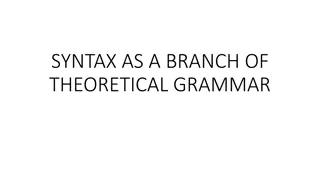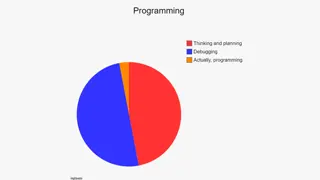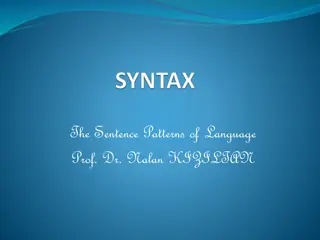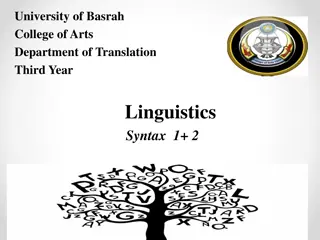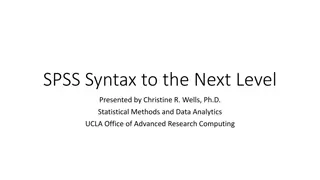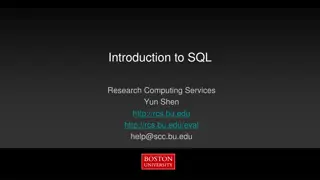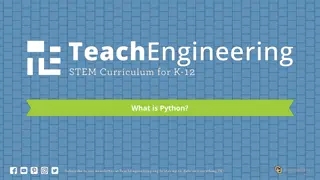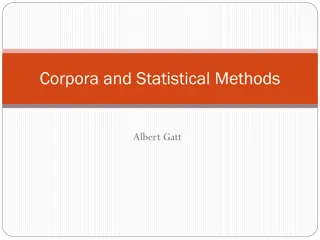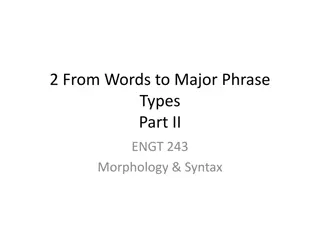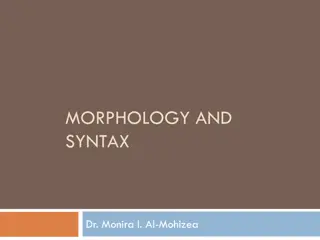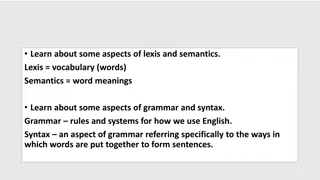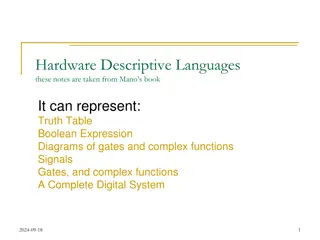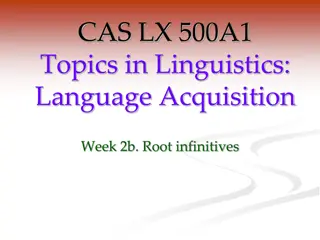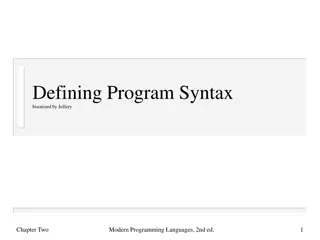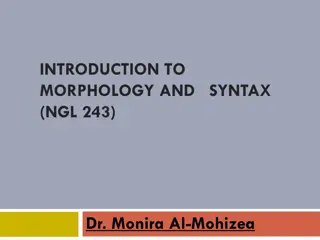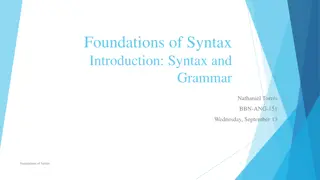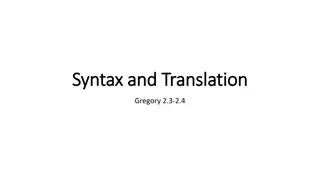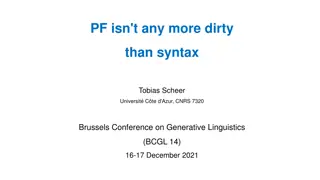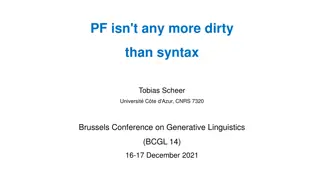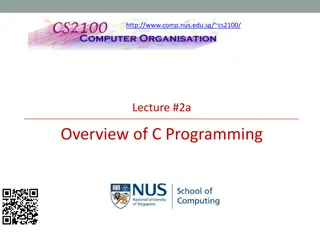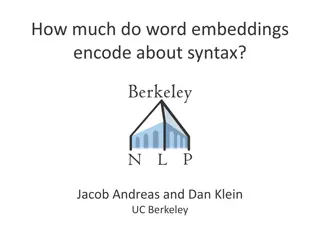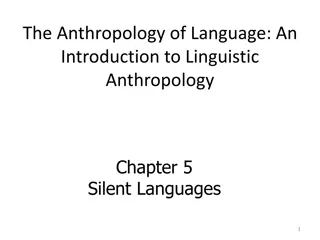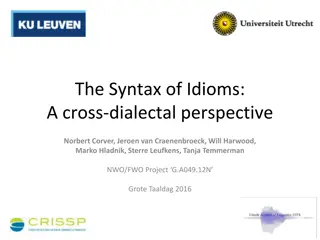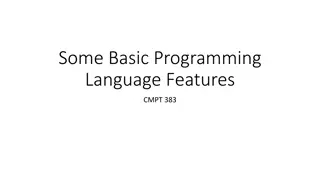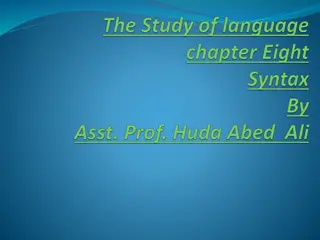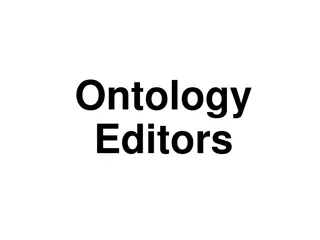Academic Language Demands and Supports in Instructional Planning
Academic Language Demands and Supports are crucial in educational settings to ensure comprehension and usage of language by students. This content discusses embedding language demands in lesson plans, providing language supports, and peer review activities to enhance academic language skills. The fo
6 views • 10 slides
Understanding Syntax in Theoretical Grammar
Syntax, as a branch of theoretical grammar, explores the combination of words in phrases and sentences, focusing on their relationships and functions in communication. Basic syntactic notions, such as syntactic units, syntactic meaning, and syntactic relations, play a crucial role in shaping the str
5 views • 17 slides
Understanding Translation: Key Concepts and Definitions
Translation involves transferring written text from one language to another, while interpreting deals with oral communication. Etymologically, the term "translation" comes from Latin meaning "to carry over." It is a process of replacing an original text with another in a different language. Translat
11 views • 76 slides
Understanding Language and Linguistics
Language is a fundamental aspect of human communication, encompassing spoken and signed forms. Linguistics delves into syntax, semantics, morphology, phonology, and phonetics to analyze language structure and meaning. Phonetics explores how speech sounds are produced and perceived, shedding light on
9 views • 10 slides
Understanding Language Syntax Through Syntax Trees
Explore how both programming languages and spoken languages can be parsed into syntax trees, revealing the syntactic structure of sentences. Learn about terminals and non-terminals in syntax trees and how they represent different components of language. Dive into syntax tree abstraction for a deeper
3 views • 32 slides
Understanding Sentence Patterns in Language: A Guide by Prof. Dr. Nalan Kiziltan
Language consists of sentences organized by grammar rules. Syntax plays a crucial role in sentence structure. This guide explores sentence patterns, syntax principles, linear order, and hierarchical structure in language, illustrated with examples and constituent tests.
0 views • 111 slides
Understanding Syntax in Linguistics
Syntax, originating from Greek meaning arrangement, deals with the structure of sentences in a language. Generative Grammar, coined by Noam Chomsky, uses rules akin to mathematics to create new, grammatically accurate sentences. By applying recursion and deep structure analysis, linguists explore th
2 views • 20 slides
Understanding Language: An Overview of Linguistics
Linguistics is the scientific study of language, a complex system of sounds, words, and patterns that humans use to communicate thoughts and feelings. Language consists of phonology (sounds), morphology (words), syntax (sentences), semantics (meaning), and pragmatics (contextual meaning). Different
0 views • 42 slides
Mastering SPSS Syntax for Advanced Data Analysis
Delve into the world of SPSS syntax with this workshop by Christine R. Wells, Ph.D., where you will learn to efficiently work with SPSS commands and subcommands, understand when commands execute, and optimize your data analysis process. Discover insider tips on setting options, using SPSS version 28
2 views • 141 slides
Learn SQL Basics: History, Syntax, and Terminology
SQL (Structured Query Language) is a specialized domain-specific language for managing structured data in relational databases. Developed in the 1970s, it follows a rigid syntax and structure, with specific features like triggers and stored procedures. Understanding SQL history, terminology, and syn
1 views • 38 slides
Understanding Python Programming Basics
Python is a popular high-level programming language known for its simple syntax, making it easy to learn and versatile for various applications. This introduction covers the basics of Python, including variables, objects, classes, and essential syntax rules like defining functions. Dive into the fun
2 views • 12 slides
Introduction to Assembly Language Syntax and Program Data
Learn about the syntax of assembly language and how data, variables, and constants are used in programming. Explore the basic instructions and the translation of high-level language into assembly language. Discover the role of an assembler in translating assembly language programs into machine langu
4 views • 36 slides
Overview of Micro and Macro Linguistics
Micro linguistics focuses on the scientific study of speech sounds, word formation, syntax, and meaning within a language, while macro linguistics delves into the societal, psychological, and neurological aspects of language use. Micro linguistic areas include phonetics, phonology, morphology, synta
1 views • 7 slides
Introduction to Corpora and Statistical Methods in Natural Language Processing
This course, CSA5011, delves into statistical natural language processing, covering language formalization, Java as an artificial language, natural language complexity, and levels of analysis in phonetics, morphology, syntax, and semantics.
1 views • 34 slides
Understanding Grammar, Syntax, and Discourse in Biblical Texts
Explore the significance of context in analyzing grammar, syntax, and discourse in biblical Greek and Hebrew texts. Learn about the foundational elements, word order, Greek syntax basics, and the importance of discourse analysis. Delve into the definitions of grammar, syntax, and discourse, and unde
1 views • 30 slides
Understanding Grammar Structures in Morphology and Syntax
Exploring the relationship between words and major phrase types in English morphology and syntax, this content delves into grammar with lexical categories, constituent structures, and the formation of phrases. It highlights the importance of considering constituents and word grouping for accurate sy
0 views • 35 slides
Understanding Morphology and Syntax in English Language
This content explores morphology and syntax in English language, covering topics like conversion, compounding, and the formation of words through various linguistic processes. It delves into examples of verb-noun conversions, productive word formation methods, and compound words. The discussion also
0 views • 27 slides
Understanding Language Structure: Lexis, Semantics, Grammar, and Syntax
Explore the basics of language structure including lexicon and semantics, grammar rules, syntax, elements of noun phrases and clauses, and types of sentences. Dive into vocabulary, word meanings, semantic fields, connotation vs. denotation, and sentence structures. Enhance your understanding of how
0 views • 8 slides
Understanding Hardware Descriptive Languages in Digital Systems
Hardware Descriptive Languages (HDLs) are used to represent various aspects of digital systems, including truth tables, Boolean expressions, gate diagrams, and complex functions. They find application in design entry, logic simulation, functional verification, circuit synthesis, timing verification,
0 views • 19 slides
Language Development in Children: Morphology and Syntax Acquisition
Children's language acquisition process involves developing morphology by adding inflectional morphemes to nouns and verbs, such as "-ing" and "-s" for plurals. Overgeneralization occurs as children apply rules, leading to expressions like "foots" and "mens". Additionally, irregular plurals and poss
0 views • 13 slides
Syntax in Language Acquisition: Root Infinitives and Small Clause Hypothesis
Children's syntactic development in language acquisition progresses from one-word utterances to combining words into basic sentences. This stage shows missing elements like tense, subject agreement, and auxiliary verbs. The Small Clause Hypothesis suggests that children initially lack certain struct
0 views • 52 slides
Exploring Sociolinguistics: Language Variation and Social Factors
Sociolinguistics delves into the study of language variation influenced by social factors, examining the relationship between language and its social context. It explores various aspects like standard pronunciation, language choice, speech acts, language components, language variety, and factors suc
0 views • 73 slides
Understanding Programming Language Syntax
This content delves into the fundamental aspects of programming language syntax, covering lexical analysis, syntax rules, and semantics. It also explores how grammar works by building parse trees, providing examples from English grammar and programming languages. The use of Backus-Naur Form (BNF) an
0 views • 43 slides
Understanding Morphology and Syntax with Dr. Monira Al-Mohizea
Explore the fascinating realm of morphology and syntax in language with Dr. Monira Al-Mohizea's insightful guide. Learn about the internal structure of words, morphemes, and the aim of morphology to uncover subconscious knowledge. Delve into discussions on what constitutes a word and various definit
0 views • 19 slides
Understanding Assembly Language Programming for Computing Layers
Assembly language is a low-level programming language that enables direct interaction with a computer's hardware components. This content explores the fundamentals of assembly language, the relationship between human-readable machine language and binary code, an assembly language program for multipl
0 views • 31 slides
Understanding the Foundations of Syntax in Language
Delve into the basics of syntax and grammar, exploring the essence of language, syntax rules, morphemes, and morphemic decomposition. Discover how syntax shapes meaningful communication and learn to identify morphemes in English words.
1 views • 17 slides
Understanding Syntax and Translation in Logic
Explore the world of syntax and translation in logic through topics such as forming well-formed formulas, identifying main connectives, De Morgan's Laws, Venn diagrams, necessary and sufficient conditions, and more. Discover the language of logic, vocabulary, truth-functional connectives, punctuatio
0 views • 46 slides
Exploring Minimalism in Linguistics: Dirty PF and Clean Syntax
This text delves into the relationship between syntax and PF (Phonological Form) in the context of minimalism theory in linguistics. It discusses how minimalism aims to achieve clean syntax by discarding imperfect elements, with PF often considered as "dirty" due to its association with phonology. T
0 views • 40 slides
Minimalist Approach to Syntax and Phonology in Linguistics
The discussion delves into the relationship between syntax and phonology in linguistics, emphasizing the minimalist approach that aims to create a clean syntax while considering phonology as an ancillary element. It explores the idea that syntax is central to grammar, while phonology is considered '
0 views • 40 slides
Understanding Language Anxiety in Foreign Language Learning and Teaching
Explore the impact of language anxiety on students and teachers in foreign language learning and teaching contexts through insights from Dr. Christina Gkonou's research. Delve into the theoretical background, implications for language education, and real-life experiences shared at the Essex Language
0 views • 25 slides
Overview of C Programming Basics and Syntax
This content provides a comprehensive overview of C programming, covering topics such as basic syntax, variables, data types, program structure, selection statements, repetition statements, and an introduction to the C programming language. It also includes a quick review on editing, compiling, and
0 views • 24 slides
Exploring Word Embeddings and Syntax Encoding
Word embeddings play a crucial role in natural language processing, offering insights into syntax encoding. Jacob Andreas and Dan Klein from UC Berkeley delve into the impact of embeddings on various linguistic aspects like vocabulary expansion and statistic pooling. Through different hypotheses, th
0 views • 26 slides
Exploring Silent Languages: Sign Language, Body Language, and Nonverbal Communication
Delve into the world of silent languages through an introduction to linguistic anthropology in Chapter 5. Explore the transmission of messages without spoken words, the intricacies of sign languages, gestures, body language, and nonverbal communication. Discover the unique syntax and complexity of s
0 views • 20 slides
Exploring the Syntax of Idioms: A Cross-Dialectal Study
Delve into the intricacies of idiomatic expressions through a cross-dialectal perspective, examining both internal and external syntax, and criteria for identifying verbal idioms. Researchers investigate the regular syntactic rules governing idiomatic structures and their interaction with non-idioma
0 views • 46 slides
Understanding Programming Language Features
Exploring syntax and semantics in programming languages, differences between interpretation and compilation, advantages and disadvantages of interpreters and compilers, and the concepts of static and dynamic behaviors in programming. Discover how different languages handle syntax and semantics, and
0 views • 7 slides
Understanding Syntax in Linguistics
Words in a language are organized into phrases and clauses with specific syntactic categories like Noun Phrase, Verb Phrase, and Adjective Phrase. Each phrase has a head such as a noun, verb, or adjective, and phrase structure rules help diagram the syntactic structure. Clauses are the largest units
0 views • 20 slides
Understanding Grammar and Syntax in Linguistics
Grammar and syntax are two fundamental components of language study. Grammar entails rules for correct language usage, while syntax focuses on sentence structures. Deep and surface structures, along with examples and distinctions between active and passive voice sentences, are explored. Structural a
0 views • 21 slides
Linguistic Evolution of Hungarian: From Ugric to Modern Syntax
The origin of the Hungarian language is debated, with doubts arising due to limited evidence of Uralic roots. Variations in syntax between Ugric and Hungarian are analyzed, suggesting a shift over time. Early Old Hungarian texts display remnants of Ugric structures, providing insights into the langu
2 views • 44 slides
Comprehensive Guide to Ontology Editors and IDEs for Ontologies
Explore a wide range of Ontology Editors and Integrated Development Environments (IDEs) for managing ontologies efficiently. From simple text editors to advanced IDEs like Protégé and Web Protege, learn about various tools and syntax options available. Dive into Ontology Editors like Protégé 4.3
0 views • 16 slides
Exploring Language, Decision-Making, and Consumer Psychology
Delve into the intricate relationship between language and decision-making, discover how advertising utilizes language to influence consumer behavior, and examine the impact of semantics and the framing effect on our perceptions. Understand the elements of language, such as phonemes, morphemes, and
0 views • 76 slides

